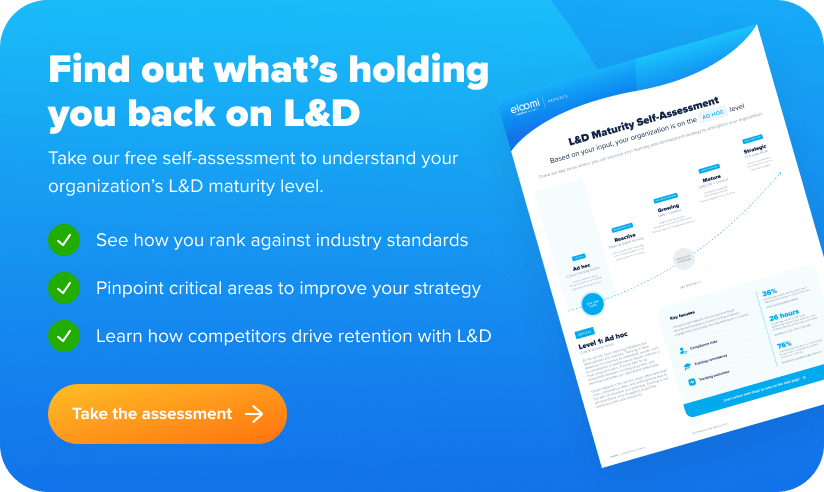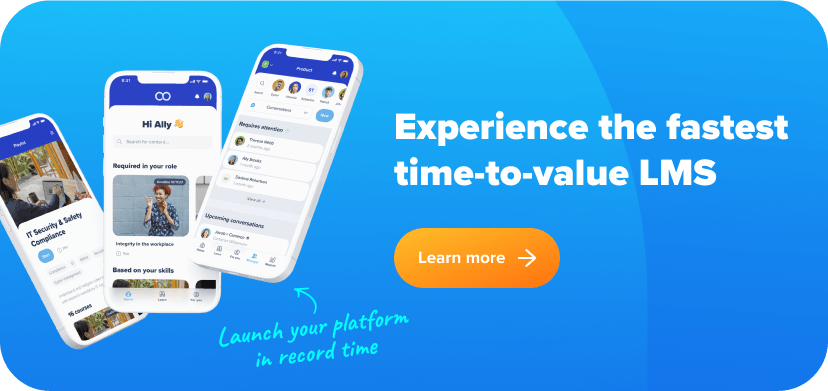However, the fact that there are so many LMS options on the market (and a whole host of available features) can make selecting the right LMS overwhelming. This guide walks you through everything you need to know to pick the right LMS for your organization.
Why choosing the right LMS matters
Selecting the right LMS can have a big impact on your organization’s success. A good LMS should drive business results, improve training efficiency, and increase learner engagement- we’ve all experienced poorly-handled training sessions that require an unhealthy amount of coffee to keep us awake. An effective LMS should make sure employee onboarding and training is never tedious or tiresome.
On the flip side, the wrong LMS choice leads to a waste of resources, bad adoption rates, and drops in training effectiveness. If there isn’t proper alignment between your organizational needs and the capability of the LMS, such challenges might impede your educational or business-related goals. Concerns over security and keeping employee data secure can also arise if the LMS isn’t managed properly such as keeping training up-to-date or using trusted vendors.

What are the different types of LMS?
Understanding how to choose the right LMS involves knowing the different types available, each catering to various needs and preferences:
- On-Premise LMS are hosted on your organization’s servers, offering full control, but they can sap your IT resources due to their required maintenance and updates. They’re also limited on the remote learning front, impacting flexibility.
- Open-Source LMS allows customization and flexibility, but requires technical know-how in-house both for setting up and further support.
- Custom-Built LMS are developed by in-house teams to meet specific organizational needs, but often come with higher costs and longer development times.
- SaaS/Cloud-Based LMS such as eloomi are becoming the increasingly favorable choice because of the overall usability, flexibility, and the fact that maintenance, updates, and security are dealt with by trusted vendors. This type of LMS is ideal for organizations looking for mobile and online training capabilities without the burden of extensive IT involvement.
What to look for in an LMS
Any LMS provider will look to promote their standout features that set them apart from the competition. But what are the most important aspects to look out for when choosing the right LMS? Due to them being used by employees, often remotely, usability and user experience are crucial. Complex features are fantastic, but if nobody is using them they’re a net loss. Equally, poor user design or lack of accessibility may bring about a low adoption rate and frustrate your users.
Other aspects to note are capabilities around customization and flexibility. An LMS should be adaptable to your needs, be it through custom branding, tailored workflows, or individual learning paths within the eLearning platform.
Another area to consider would be integration: an LMS should be easy to integrate with other tools and systems in use at your organization, such as HR software, CRM, and content management systems, or even MS Teams. An LMS that doesn’t integrate well with your existing systems can add unnecessary administrative burdens, making it more challenging to manage. It should also be scalable, so an LMS needs to be able to grow with the organization. Lastly, support and training can’t be overlooked; a good vendor should provide good training and customer service to ensure ease of implementation and its subsequent usage.

How to choose the right LMS in 7 steps
Now that we’ve discussed the considerations to make when looking for an LMS, let’s dig into the process of choosing the right LMS. The following steps will help you make an informed decision:
1. Identify your organization’s needs
Determine the primary goals (e.g. employee onboarding, compliance, skill development), understand your target audience (consider their tech proficiency and learning preferences), and identify key features you need (like mobile access, reporting, or certification management).
2. Define your budget
Set a realistic budget that covers both initial and ongoing costs. Consider the return on investment by evaluating how the LMS will contribute to your organization’s goals, such as reducing training costs, improving employee performance, or saving HR time.
3. Explore LMS features
Prioritize the core functionalities, ranging from user-friendly interfaces and compatibility with mobile devices to robust reporting and content creation tools. Think about more advanced features in those areas that might also be aligned with the purpose: social learning, performance management, and AI-driven recommendations.
4. Evaluate vendor reputation
Research potential vendors by looking at customer reviews, case studies, and industry ratings. Check the quality of their customer support, including response times, availability, and the resources they provide for training and troubleshooting.
5. Request demos
Request demos from shortlisted vendors and involve key stakeholders in the evaluation process. Use these demos to assess usability, functionality, and how well the LMS meets your organization’s needs. Trials are also an excellent opportunity to experience the platform firsthand.
6. Gather feedback from stakeholders
Collect feedback from potential users, including administrators, trainers, and learners. Their insights on the LMS’s usability, feature set, and overall experience will be invaluable in making a decision that benefits everyone involved.
7. Make an informed decision
After gathering all necessary information, weigh the pros and cons of each option. Consider your organization’s needs, budget, and stakeholder feedback to choose the LMS that best aligns with your long-term goals.
Success stories of choosing the right LMS
Selecting the right LMS can lead to significant improvements in training performance, and the following examples demonstrate the value of choosing the right LMS. Before implementing eloomi, Monitor ERP, an ERP provider aimed at manufacturers, faced challenges in scaling their training efforts across multiple locations and ensuring consistent employee development.
After launching eloomi internally in 2019, Monitor ERP experienced impressive results:
- By 2022, Monitor ERP celebrated a milestone of 100,000 courses completed.
- Nearly 14,000 Monitor ERP users successfully completed their training with eloomi.
- With eloomi, Monitor ERP saved on average 2-3 days per implementation project.
KOMPAN, a manufacturer of commercial playground equipment, needed a robust platform to manage and distribute compliance training across its global workforce. By choosing eloomi, KOMPAN was able to:
- Successfully distribute compliance training across the entire organization of over 1000 employees.
- Leveraging eloomi’s multi-language platform, employees accessed the training in 10 different languages, catering to the diverse needs of a global workforce.
- The new training program saw 100% engagement and completion rates.
Finding the LMS for you
Finding the right LMS is a choice that will significantly help and even reshape learning and development initiatives within any organization. It’s important to recognize that an LMS is a strategic asset that can transform your approach toward learning. By following our guide on how to choose the right LMS, we hope you’ll now be in a position to choose an LMS that can drive success and growth.
Are you new to eloomi and want to learn more? Book a demo with one of our product specialists to learn how to simplify your team’s learning and development with an all-in-one LMS training platform.







